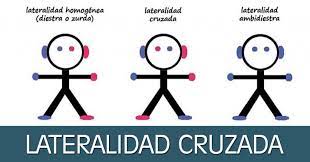

lateralidad
05/03/2023
LATERALIZATION AND CEREBRAL HEMISPHERIC DOMINANCE From three to four years of age, a lateral preference begins to appear in humans, which is completed around eight years of age to lead us to the percentage statistics of 64 pure right-handers, 32 ambidextrous and only 4 pure left-handers. That is, only 4% of humanity is totally left-handed <2). The lateralization is not always homogeneous (eye, ear, hand, and foot), but it can be heterogeneous, that is, it can have combined lateralizations. The diagnosis of lateralization is made through the application of batteries of psychological tests and through the observation of the functioning of eyes, ears, hands, arms, legs and feet. There are simple tests such as seeing through a monocle, hearing the ticking of a clock, cutting with scissors, crossing the hands and arms, clapping, crossing the feet, putting on pants, kicking, jumping, kneel down. These tests show the preference to use right or left organs or limbs (3). The dominant cerebral hemisphere is larger and heavier. In most humans, including lefties, the left is the dominant hemisphere. The left hemisphere is logical, symbolic, mathematical, verbal, analytical, abstract, reasoning; prevails in language. It processes information from the right eye and ear and governs the motor activity of the right hemibody (4) <5). The right hemisphere, dominant in some lefties, is instead spatial, intuitive, non-verbal, synthetic, emotional, musical, concrete, artistic; predominates in visual functions and motor. It processes information from the left eye and ear and governs the motor activity of the left hemibody (4)(5). In "dichotic listening" scans (in which information is supplied to both ears simultaneously) it has been found that the right ear (left hemisphere) perceives better syllables, words and figures while the left ear (right hemisphere) better captures melodies and noises.















